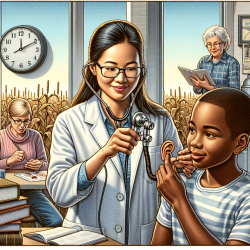Empowering Change: Unveiling Latent Social Threats Through Tabletop Simulations
In the dynamic field of speech-language pathology and healthcare, the ability to collaborate effectively across disciplines is crucial for delivering optimal care. A recent study titled Getting everyone to the table: exploring everyday and everynight work to consider ‘latent social threats’ through interprofessional tabletop simulation sheds light on a novel approach to enhancing interprofessional collaboration through tabletop simulations. This innovative method not only identifies latent social threats but also fosters a deeper understanding of the everyday work that shapes healthcare delivery.
Understanding Tabletop Simulations
Tabletop simulations are a low-resource, discussion-based modality that allows healthcare professionals to explore and address interprofessional challenges. Unlike traditional simulations that focus on individual competencies, tabletop simulations emphasize the collective work processes and the social and structural forces that influence them. This approach provides a unique opportunity to simulate healthcare practices over extended periods, uncovering the 'latent social threats' that can arise during interprofessional clinical care.
Key Insights from the Research
The research conducted by Brydges et al. (2021) highlights several key insights that can empower practitioners to improve their skills and foster better outcomes for children and other patients:
- Interprofessional Dialogue: Tabletop simulations create a platform for open dialogue between professional groups, enhancing understanding and cultural change.
- Mapping Work Processes: The simulations help map the texts and documents that govern everyday work, facilitating system change and managing latent social threats.
- Identifying Latent Social Threats: By simulating real-world scenarios, practitioners can identify social factors that contribute to errors or communication breakdowns.
Implementing Tabletop Simulations in Practice
For speech-language pathologists and other healthcare professionals, implementing tabletop simulations can be a transformative step towards improving interprofessional collaboration and patient outcomes. Here are some practical steps to consider:
- Engage in Continuous Learning: Embrace the tabletop simulation approach as a tool for ongoing education and quality improvement.
- Collaborate Across Disciplines: Work with colleagues from different professional backgrounds to design and participate in tabletop simulations.
- Focus on System Change: Use the insights gained from simulations to advocate for changes in policies and practices that address latent social threats.
Encouraging Further Research
The findings from this study provide a foundation for further exploration into the use of tabletop simulations in various healthcare settings. Practitioners are encouraged to delve deeper into this research and consider how it can be adapted to their specific contexts. By doing so, they can contribute to a broader understanding of how to effectively manage latent social threats and improve interprofessional collaboration.
To read the original research paper, please follow this link: Getting everyone to the table: exploring everyday and everynight work to consider ‘latent social threats’ through interprofessional tabletop simulation.










